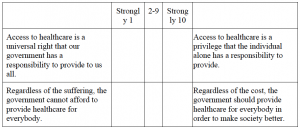Ben Ader and Kelly Patterson, Political Science
Introduction
This project was an experiment to help understand the views of Utahns on healthcare and whether or not healthcare can be included in a list of basic rights. We also assessed the many dimensions of healthcare and where Utahns lie on a graph measuring the intrinsic motivations for or against healthcare as a basic right.
Methodology
For this project we conducted a survey through the Utah Voter Poll, which was completed by a group of Utahns demographically similar to the rest of the Utah electorate. In order to understand the underlying values and attitudes associated with healthcare we asked a question that breaks down the possibly differing opinions into three categories. We hypothesized that there are three dimensions to how individuals form opinions about healthcare; personal, bureaucratic, and compassionate. With these three dimensions of how to consider healthcare we created an experiment with different question stems that were randomly assigned to each respondent. We tested the differences between these dimensions through varying referents in our three treatments.
The question stem for the control question simply asked the respondent to indicate the extent to which he or she agrees or disagrees with three statements that describe varying types of healthcare systems. The three treatments change slightly by attempting to provoke thoughts either of an individual’s personal doctor, the sicknesses that healthcare is intended to treat, or the bureaucracies that are used to obtain healthcare. We specifically referenced doctors and nurses in hopes of showing a difference in trust between the institution and the individual respondent’s personal doctor. Through referencing the sicknesses the instrument prompted more sympathetic thoughts, possibly about friends or relatives each respective respondent knows with some illness that requires healthcare to treat. By referencing the bureaucracy or the specific organizations through which healthcare is obtained the instrument fomented thoughts about the costs and possibly past experiences relating to each organization. We expected that the first treatment would be associated with a higher support for response option B, the second treatment for response option A, and the third treatment for response option C. The question appeared as follows:
- Control: While considering the best way to think about healthcare services, please indicate the extent to which you agree or disagree with the following statements.
- Treatment 1: While considering the best way to think about healthcare services provided by your own doctor, nurse, or other health professional at the local hospital or your family clinic, please indicate the extent to which you agree or disagree with the following statements.
- Treatment 2: While considering the best way to think about healthcare services provided by HMO’s, Medicaid, private insurance, and hospital chains, please indicate the extent to which you agree or disagree with the following statements.
- Treatment 3: While considering the best way to think about healthcare services for illnesses that range from the basic flu or asthma to the most advanced stages of cancer or emergency treatment for trauma victims, please indicate the extent to which you agree or disagree with the following statements.
- Response Options:
- A. Healthcare services are ‘private goods’ that people should buy somewhat like cars and televisions, and based on what they want and can afford.
- B. Basic healthcare services should be available to everyone, like public education, but people who can afford to should be able to buy more or better care, similar to paying for private schools.
- C. All effective healthcare services should be universally available, provided to everyone as a right of citizenship and based on the services they need.
We also had two sets of statements where the respondents were asked to move a widget along a scale closer to whichever statement they agree with more. The statements are intended to provoke thoughts of either economic costs or moral responsibility associated with healthcare. The statements appeared as follows:
Move the point along the scale toward the statement that is closer to your opinion.
Results
I regressed each question on the treatments and controlled for race, income, gender, party ID, ideology, education, and age. None of the treatments had a statistically significant effect. Despite these null results, each respondent also answered two widget questions. These clearly show that more extreme language about responsibility seems to moderate respondents, whereas milder language about rights polarizes the respondents. Though it is hard to find statistical significance in my treatments, the results show mild but interesting effects on the opinions of voters.
Discussion
The results mainly show a theoretical appearance of variation that tells a nice story about the appearance of being extreme. But the most likely way for me to attain better significant results would be to include a future analysis of the widget questions with a quadratic element added to my regression. This type of analysis would require a level of statistical sophistication beyond my abilities, but could result in an interesting relationship between the responses.
Conclusion
My project resulted in null results but created a framework from which more analysis could be done to achieve potentially interesting results.

